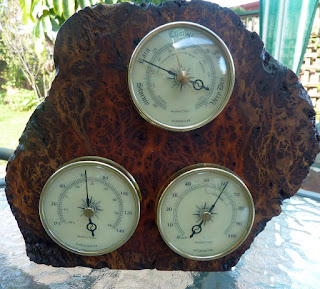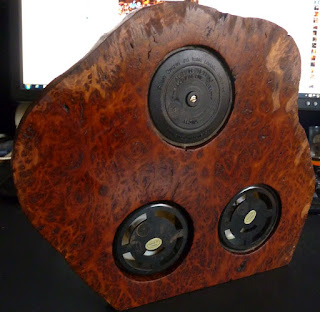The chuck had a 3/4" 19mm bore - spindle thread which wouldn't fit any lathe I had, I had arranged to have it drilled and tapped to 1"x10 to fit the Jet mini spindle but Tim moved to greener pastures.

The 4 jaw chuck as it was prior machining and new washers.


Rear of the chuck showing original washers which were to small.
Below the jaw lead screw.
Now I have the Myford ML7 I had the opportunity to do this myself.
After removing the jaws of the wood chuck I mounted the chuck off the rear spindle shaft in the 3 jaw chuck on the Myford to check balance and run out.
Above and Left mounted in the 3 jaw chuck.
Right a spray with WD40 and a clean up.
My first mistake was just doing this visually, my second mistake was then mounting it in the 4 jaw chuck with the face to the headstock.
Having not checked run out using a dial gauge when it was mounted in the 3 jaw where I should have just drilled and tapped the bore using the 3 jaw chuck then checked run out again.
Lesson learnt.
Below I bored an area or 5mm to allow a clear shoulder.
Right showing the clearance of the jaws to the bed of he lathe.
Once the bore was drilled and tapped 1"x10 I was able to fit it to the Jet mini Variable speed lathe I have......well I thought so. Seems the Jet spindle thread was tapered to the headstock and hardened, Ken came to my rescue we tried using my 1"x10 die to cut the thread but as it was hardened it only cleaned the thread or removed very little. Ken used a diamond file to deepen the pitch and used an adjustable reamer to remove some thread peak in the bore of the chuck. That worked, we got it to screw up tight to the shoulder.

Test fitting to the Jet.
Below parting a washer.
All this testing was done without the jaws fitted. I used a dial gauge to check run out I got a .005 thou reading on the face in two areas, and a .007 on two way sections where the jaws run. The ways obviously had not been machined at all as the sand casting impression was not machined.
I re-mounted the 4 jaw chuck into the 3 jaw Myford chuck and machined the face (yes I checked run out first it matched that of the run out on the Jet Mini).
I also machined the out edge which wasn't square to the face even prior machining.
I used a file to level the ways (one day I'll learn to hand scrape) the filing proved positive.
In remounting the 4 jaw to the Jet Mini it ran much better but still the vibration was there at around 1350 RPM to 1500 RPM so an improvement. In considering machining the webbing area of the back of the chuck which of course is cast iron, I can machine the ways and inner rim but the rough cast area is something else if thats where the vibration is coming from. Even with the jaws fitted and new washers little change was made.
Ken suggested it may be the bearing of the Jet Mini checking using the Nova chuck shows no vibration.
My use of the chuck is more for surface decoration of turned items not as a high speed/RPM chuck. So my work RPM will generally be below the vibration area.
I will look further for the problem but my hunch is the casting itself.
The finished chuck with jaws mounted. I have a Chuck key to make I will be using a 3/8" extension bar of a socket set weld a T bar to it.





































